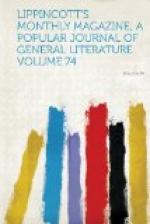Once within the great enclosure, the reason for its having been called Garden Key becomes apparent. The neighboring islands are covered with prickly pear, mangroves, and bay-cedars, while here clumps of cocoanuts rear their graceful forms, their long rustling leaves, which convey to the distant listener the cooling impression of falling rain, reaching high over the top of the fort. On the west side grows a small grove of bananas, while against the cottage walls luxuriant vines climb in wild confusion. What was once the parade-ground is covered by a thick growth of wiry grass, in which gopher- and crab-holes lay traps for the unwary. In fact, far from being the forbidding spot it has been painted, Dry Tortugas seemed to us a veritable garden in the path of the great Gulf Stream.
On the afternoon of our arrival the Bull Pup was got under way and headed through a circuitous channel to East Key, off which we came to anchor about dusk. Blankets and other articles indispensable for a night on the beach were carried ashore, and camp formed on the edge of the bay-cedars. East Key comprises about thirty acres of sand, thickly covered with a low growth of bay-cedar, in which the rude nests of the noddy are found, while here and there in the undergrowth are great patches of cactus or prickly pear, affording lurking-places for innumerable purple-backed crabs of ferocious mien.
“Turklin’,” said old Sandy, as we lay stretched on the sand, waiting for the moon, “is right in de line o’ hard wu’k, an’ I ‘spec’s yo’ chillun is a-hankerin’ after yo’ mudder.”
The two children, both hard on thirty, indignantly denied that they had anything but an extreme fondness for labor.
“Wu’k!” said old Sandy, appealing to us and reaching for a piece of driftwood to fling at his progeny in case of necessity; “w’y, de coons of disher generation don’ know de meanin’ of de word, da’s a fac’. How is it dat yo’ don’ see no mo’ bandy chillun roun’ now? Kase dey mammies don’ hev to wu’k. Dey ain’t got no call to put de chilluns down. W’y, chile, I pick cotton ‘fore I leave de bre’s’, da’s a fac’. De niggers is gittin’ too sumpchus fo’ dar place. Dey try to make outen dey got sense like white folks. Yo’ Rastus, yo’se deacon in de Key Wes’ Fustest Bethel, ain’t yo’?”
“’Deed I is,” replied that person.
“An’ Piffney too, I reckon,” continued Sandy.
“Yas, sah,” answered Piffney.
“Wal,” said the old man, turning to us again, “dere it is. Chuck full o’ ’ligion, but w’en dey git in de tight hole like de five-foot dey ain’t got no faith. Old-time l’arnin’ say ‘tain’t no use buckin’ ’genst de debble less yo’ full o’ faith. All de old-time coons knows dey’s coons, but dese yere free-born darkies got to be white or nuthin’. Yander,” nodding his head toward Key West, “a couple of dese yere black Conchs drap in on me an’ de ole woman, an’ say, ’Uncle Sandy, we’se ‘lected yo’ hon’ry member of de




